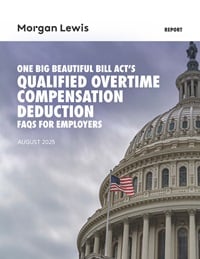One Big Beautiful Bill Act’s Qualified Overtime Compensation Deduction: FAQs for Employers
August 2025
This report details the complexities of the Qualified Overtime Compensation deduction provisions in the One Big Beautiful Bill Act (OBBB).
The Qualified Overtime Compensation (QOC) deduction rules—codified in new Internal Revenue Code (IRC) Section 225—provide a potential federal income tax deduction of $12,500 per year for qualifying taxpayers who file a Form 1040 individual income tax return under the “single” filing status, while qualifying taxpayers who file a Form 1040 individual income tax return under the “married-filing-jointly” status may be able to claim a maximum QOC deduction of $25,000 per year. The QOC deduction phases out at above certain income levels (discussed below), and it is only available on certain overtime pay required under the federal Fair Labor Standards Act (FLSA) that a taxpayer earns between January 1, 2025 and December 31, 2028. New IRC Section 225(c) requires employers to report QOC on Form W-2 wage statements issued to employees and requires service recipients to report QOC on Form 1099-NEC payee statements issued to independent contractors. The IRS announced that updated information return templates (e.g., Forms W-2 and 1099) will not be published for tax year 2025, and that employers should “continue using current procedures for reporting and withholding” with respect to QOC paid during 2025. Given the IRS’s delay, employers can likewise delay implementing any of the QOC information return reporting requirements until the 2026 tax year. Nevertheless, there are important steps employers should take now.
Implementation and communication for QOC reporting for 2026 require a clear understanding of what IRC Section 225 entails. The FAQs discussed in this report highlight some of the key questions about the QOC deduction that employers should be answering now, in an effort to avoid employee confusion and IRS incorrect information return penalties in the future.
KEY RECOMMENDATIONS
- Develop a communications plan to educate employees and manage employees’ expectations. For example, employees may not appreciate that not all “overtime” is considered QOC. Employees who are exempt from the FLSA’s coverage or who receive overtime under non-FLSA rules may not realize that they do not qualify for the deduction. Additionally, employees may not appreciate that the changes only affect federal income tax deductions.
- Review if employees are properly classified as exempt from FLSA overtime protections and assess overtime protocols and practices.
- Monitor regulatory guidance, including future guidance on QOC and reporting from the IRS and from state taxing authorities.
- Review payroll and reporting systems. Begin working with payroll and legal teams to ensure that payroll systems can (1) identify the “overtime premium” of FLSA-required overtime pay, and (2) can segregate these premiums for future (i.e., 2026-2028) Form W-2 reporting purposes.
Contacts
If you have any questions or would like more information on the issues discussed in this paper, please contact the authors or lawyers in our benefits and payroll tax and wage and hour litigation and counseling practices.